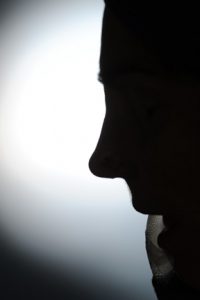Aesthetic Plastic Surgery Norwegian Cruise Lecture
While still on the American Society For Aesthetic Plastic Surgery Norwegian cruise, I gave a second lecture on rhinoplasty and the importance of recognizing the limits of the skin. So much attention is paid to the nasal skeleton, manipulating it with sutures and struts, that not enough attention is placed on the skin, which limits what the surgeon can do and determines the beauty of the result. Most postoperative problems are the direct result of the surgeon’s misapprehension of what the skeleton and skin will do after they are changed and as they heal.
This wonderful woman had undergone two prior surgeries and had a chronic runny nose, had become a mouth
breather, and had a new airway obstruction. She was incapacitated with sleep and with exercise. These were
all problems produced by soft tissue and skeletal collapse. Her silhouettes are shown at the beginning [yellow] and end [blue] of my surgery. Notice how the skin is shaped by the underlying reconstructed skeleton. Also observe how bridge and tip shape change favorably and how the nose shortens as it gains support.
 I just saw her again this week. She is no longer a
I just saw her again this week. She is no longer a
mouth breather. Her rhinitis has completely stopped,
and she is delighted with her nasal appearance, which
resembles almost exactly what I produced on the
operating table.
This is the great control that closed rhinoplasty provides
for the surgeon. By the methods that I used to brace the
internal and external valves, the airway is normal when
the dressings come off at 6 days, and it stays that way.
Swelling is minimal, recovery is quick, and the need for
secondary surgeries, except in complex cases, is relatively
low because the surgery is so directed and nondestructive.